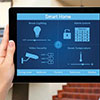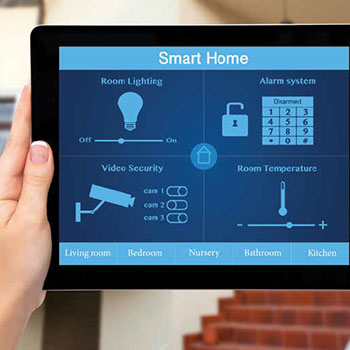
Opportunities and Challenges for Home Security
Your home will be getting smarter and able to do more for you
- By Rob Phillips
- Jul 01, 2014
 Where is home security
headed?” A better question
is, “Where can’t it go?”
ABI research recently
predicted that in the next five years, smart home
services will grow 37 percent in the United States.
New automation solutions are opening all kinds of
new possibilities for customers who are looking to
integrate convenience and security.
Where is home security
headed?” A better question
is, “Where can’t it go?”
ABI research recently
predicted that in the next five years, smart home
services will grow 37 percent in the United States.
New automation solutions are opening all kinds of
new possibilities for customers who are looking to
integrate convenience and security.
As always, competition is the best indicator
of growth. The entire market has shifted with the
entry of telecom giants like AT&T, Verizon and
Comcast, which is expected to finalize its merger
with Time Warner Cable later this year.
Rapidly growing technology brings both opportunities
and challenges to our industry that
dealers are digesting now and will be down the
road as home automation creates remote lifestyle
options that simplify a customer’s daily schedule.
Electronic Dispatch
The Central Station Alarm Association’s ASAP
(Automated Secure Alarm Protocol) program is
a national program in which police departments
and monitoring centers exchange dispatch information
electronically to reduce average dispatch
time to a matter of seconds. ASAP has a serious
automated premise: cooperation among central
stations and law enforcement to get assistance to
individuals more quickly during emergencies. It’s
currently available in select areas: Houston, Texas;
Richmond, York County and James City County,
Va.; Washington, D.C. and Tempe, Ariz.
“Electronic dispatching has been a dream of
mine since getting into the monitoring business,”
said Darin Anderson, vice president of monitoring
operations at Monitronics, an ASAP charter member.
“I have always seen the potential to utilize technology
in this way, but it was not a reality when I left
the alarm business in 2010.
“When I came to Monitronics in 2012, I happened
to land in a central station that was participating
in ASAP, and it rekindled my belief in
its potential.”
If enough of the country’s 6,000 PSAP’s (Public
Safety Answering Points) team up with the hundreds
of operational monitoring centers, ASAP
could become an industry game-changer. This
program dramatically speeds up emergency response
and eliminates human error in transferring
information between operators. Everyone
wins—alarm companies, emergency agencies and
customers.
Video Monitoring
and Apps
Remote video and image surveillance
has generally seen less market
penetration than other interactive
service features. With the cost of
IP cameras dropping, it’s becoming
more cost-effective for customers
and an even greater upsell opportunity
for dealers.
New viewing options are available
for customers with cameras in
and around their home. Touchscreen
devices enable homeowners to view
video directly from their panel. If the
camera’s pointing at their front door,
they can see who knocked/unlocked
their door right from the screen.
New technology is benefiting
dealers in everyday operations. Dealer
programs, like Monitronics’, have
created exclusive mobile applications
for their dealers in the field.
Their eContract app allows salespeople
to quickly complete an electronic
version of each contract in the
customer’s home from an iPad or Android
tablet. It saves dealers money
and presents contracts to customers
in a digital format that corresponds
with their interactive products.
LOCATE, currently being piloted
by their program, gathers vital information
about customers in a given
area: names, household incomes,
and whether they own or rent. It
syncs with Google Maps to provide
accurate, up-to-date addresses and
directions. Salespeople can address
customers by name and build an instant
rapport at the door.
Other public apps can also make
life easier for dealers:
iTeleport acts as a traveling PC,
allowing control of an office desktop
computer from a tablet or smartphone.
BatchGeo creates a simple map
that plots all customers or prospects
via Google Maps. Dealers can pop in
to visit old customers while they’re in
the neighborhood, see how service
is going and ask for referrals. All it
takes is uploading a client, like CSV
list, onto the app’s website, and then
setting parameters and rules.
Google Voice is a convenient
traveling tool that routes all calls
from a dealer’s office or cellphone to
a single, unique Google Voice number.
A free, local phone number can
be created to distribute to customers
that will route to an out-of-state
number, which creates a local feel
with customers who might normally
ignore an out-of-state phone call.
The 2G Sunset
Now, a challenge. One byproduct
of evolving technology is it eventually
gets outdated. The inevitable
2G technology phase-out affects all
kinds of service, but this is critical information
for customers who rely on
their alarm to protect them via active
communication to a central station.
AT&T and other wireless carriers
have started the 2G sunset in certain
areas of the U.S. Current customers’
cellular radios or panels must be replaced
to ensure their alarm monitoring
service continues without
interuption.
The challenge for security companies
is staying aware of fading cell
towers, informing their customers of
the impending changes and making
updates in an efficient manner. All
of that requires understanding the
costs for repair work and contacting
customers about the change to their
equipment.
This article originally appeared in the July 2014 issue of Security Today.